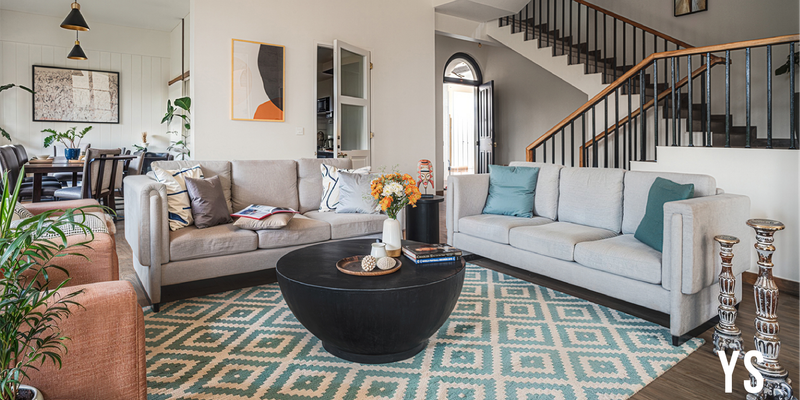[ad_1]
Picture a charming villa, situated in a quaint Goan village, with a private pool and garden. Fully furnished, with interiors designed tastefully to reflect your taste. Armed with world-class amenities like concierge services, a gym, a pickleball court, and spaces for walking, these villas are housed inside a safe gated community in some of the most sought-after locales across the state.
All of this, set in one of the country’s most unique states – Goa. Where frenetic festivals are juxtaposed with a relaxed and easy pace of living, offering modern professionals the perfect spot to work and play. Home to diverse communities, faiths and languages, the sunshine state has opened its doors to many home seekers in the last few years.
Influenced by 450 years of Portuguese rule, Goa is a unique amalgamation of Portuguese and Indian culture, reflected in their architecture, cuisine and customs.
A haven of luxury real-estate
Over the years, Goa’s appeal has become way more than just its signature beautiful beaches, nightlife, and cuisine. What was once India’s go-to vacation spot is now transforming into a hotbed for luxury real estate. Affluent buyers are exploring options for luxury real estate in the most coveted locations across the state. Given that land in Goa is a scarce resource, and clear-titled land even more so. The Chapter offers home-buyers a chance to own a clear title property in Goa, often tracing it back two generations to find its rightful owners.
This trend of buying luxury real estate in Goa is driven by several factors—capital appreciation, scenic beauty, infrastructural developments, and regulatory support. Furthermore, factors like escalating pollution and overcrowding in metros and other major cities in India are pushing buyers to look beyond the boundaries of their cities.

According to a survey conducted by India Sotheby International Realty, 71% of respondents (all high net worth and ultra-high net worth individuals) expressed intent to buy real estate in the next one to two years. This includes successful millennials and Gen Z professionals, who are looking to move from crowded and polluted cities, work remotely for a few months in Goa, or are searching for the perfect second home.
Goa is an extremely attractive prospect for these buyers as it offers substantial capital appreciation potential. Communities and properties in highly desirable areas have witnessed significant value increases over the years, making it the perfect opportunity for investors looking to reap high returns.
Villas built by The Chapter are the perfect representation of this development. Not only is each home designed and furnished as per the owner’s aesthetic sensibilities (eliminating the need for interior designers) and functional requirements, it is also maintained post-sale through seamless property management services, ensuring that the property doesn’t become a white elephant. The pool and the gardens remain well maintained, and the furnishings are well looked after.
The plot thickens: infrastructural developments in Goa
Goa has also transformed into a residential hotspot for buyers in India and abroad due to significant infrastructural developments. With increased connectivity, it is more accessible than ever. The new Manohar International Airport in Mopa has allowed NRIs and international homeowners from Singapore, New York, London, and more to consider investing in a premium Goan villa.
New highways, bridges, and roads have also made various parts of the state even more accessible, significantly boosting the real estate market. Additionally, the state government has also put pro-investment policies in place, attracting high-end buyers.
A luxury chapter in residential real estate
The Chapter was founded with a simple mission—building beautiful homes in harmony with the owner and the wider community. These villas balance modern comforts and Goan culture with nature, serenity, sophistication and international standards of living.
The company uses a tech-forward approach, streamlining and simplifying the home-buying experience. From the purchase of the house to designing its interiors, taking care of the furnishing and decor, as well as any management required post-purchase, homeowners are assured of starting this new phase in Goa in style and comfort.
Buying a home with The Chapter is a collaborative process. The company works hand in hand with homeowners to bring their vision to life, courtesy an efficient tech platform, which allows customers to select curated design themes for each space in the home. Customers can access these designs on a tablet, choose a specific theme and see it applied to the chosen space. The platform streamlines the process, allowing customers to make quick decisions based on what they see.
The design identities were carefully curated and crafted to meet a wide range of tastes and aesthetics. Each theme meets international standards of design, and can be applied to an individual room, or the entire home. The Chapter aesthetic draws inspiration from modern luxury, travel, and heritage. From the Modern farmhouse theme, where earthy meets elegance, to the Santorini style, with its vivid blue and white shades—each template or mood board offers colour palettes and designs that appeal to a variety of tastes.

Providing homeowners with the finer things in life
The company’s first project in Moira – Volume 001 – sprawls over 2.24 acres of land and features 22 neo-portuguese homes, each with a swimming pool, manicured garden and a stunning view of the winding Moira river. The property in Moira —Volume 001 (RERA: PRGO01231855) with its Portuguese-inspired villas—sold out in a record six months.
The second property, Volume 002 (Part 2 RERA: PRGO04242208) is located in Aldona (close to Assagao and the new airport in Mopa) and features 27 exquisite Portuguese-inspired villas, each equipped with a private pool and garden, as well as world-class amenities.
For those looking for a break from the breakneck speed of crowded metros, The Chapter villas offer a chance to build a home, community, and life in sun-soaked and serene Goa.
To discover Portuguese-inspired villas at Volume 002 Aldona,
[ad_2]
Source link





